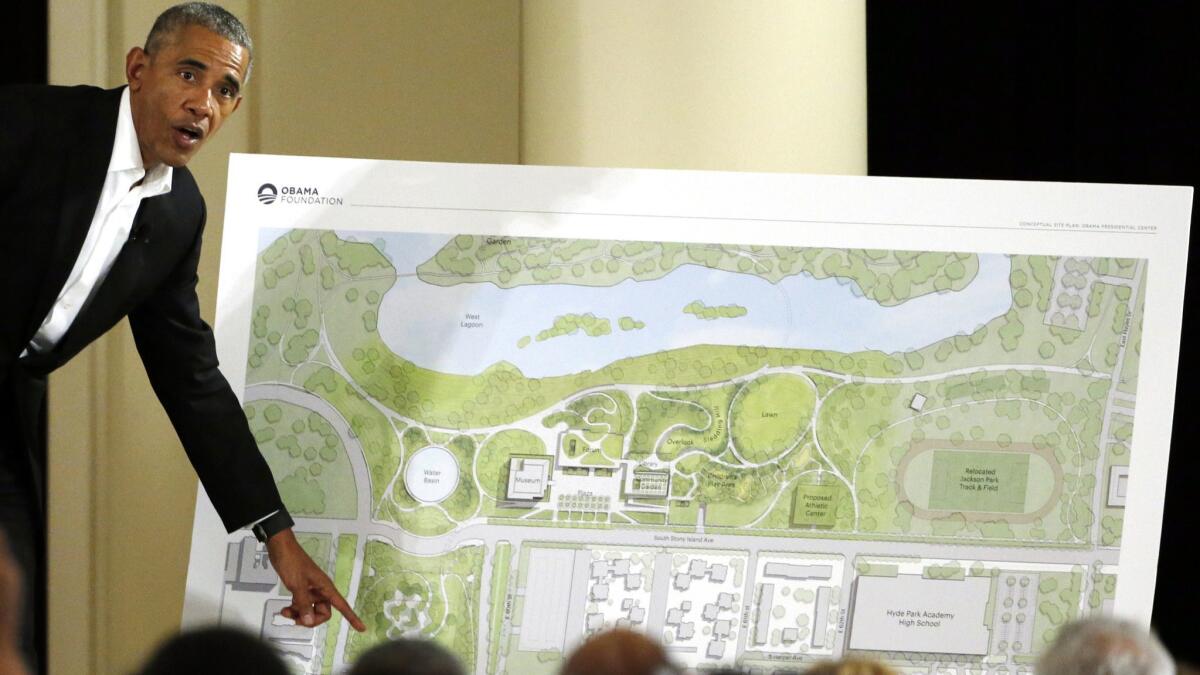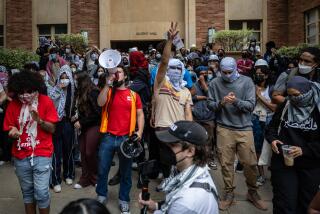Obama Presidential Center in Chicago gets initial approval, but many hurdles remain

Reporting from CHICAGO — Plans to open the Obama Presidential Center on Chicago’s South Side have cleared a major hurdle, but a recent approval from city planners is just the beginning of a long process before construction gets underway.
This week, the Obama Foundation will go before the zoning board for more approvals. Then it will need a formal long-term lease agreement approved by the full City Council. In addition, the project is still under federal review because Jackson Park, the planned construction site, is listed on the National Register of Historic Places.
Still, the vote last week was considered a major victory for the foundation’s top officials, who represent the former president and first lady.
“We are pleased with the vote and look forward to continuing to work with our neighbors ... to make the vision and mission of the OPC into a reality,” David Simas, chief executive of the Obama Foundation, said in a statement.
Of the 22 members of the Chicago Plan Commission, 15 voted on the matter, all in favor.
In May 2015, then-President Obama and Michelle Obama announced that they wanted to build the presidential center on the South Side, eventually selecting Jackson Park as the site for the sprawling complex. The choice of location, they said, would place the center near the Museum of Science and Industry and benefit struggling neighborhoods such as South Shore, Woodlawn and Washington Park.
But from the moment the details of the project were unveiled, it has exposed sensitive divisions in the South Side community along both racial and class lines.
Some residents have expressed worry that the project will lead to gentrification and displacement. Others don’t want the facility in park space or complain about increased traffic.
On the other side, supporters said the center will provide a much-needed investment that could lead to a transformation of the South Side and provide jobs, workforce training and other opportunities for African Americans, Latinos and other often-neglected groups.
On Thursday, much of that tension came to a head at the meeting. In the City Council chamber, nearly every seat was filled, and the balcony area was crowded too. Nearly 250 people signed up to speak. Testimony lasted seven hours.
Five hours before the meeting started, in the chilly darkness of morning, opponents and supporters of the center staged dueling rallies outside City Hall. Carrying signs and banners, they stood across the street from each other yelling chants.
Then, once the meeting started, several residents were removed by security after they disrupted the proceedings.
When it was time to explain the specifics of the center, the foundation’s chairman, Martin Nesbitt, took the podium.
“Our vision is that the center is a public campus integrated into the park as a part of it and not apart from it,” Nesbitt said. “When families and young people come to our campus, we hope to have them inspired to see that they have the power to change the things in their lives and the communities they live in.”
The center also aims to “broaden horizons for kids on the South Side,” he said.
He said the contractors hired to build the center are mainly African American-owned firms. The foundation has also committed to providing training and career centers so that it can create a pipeline for residents to get permanent, well-paying jobs.
The center is envisioned as a 19-acre campus made up of three buildings: a museum tower that will reach 235 feet and eight levels, a forum containing a 300-seat auditorium, and another building that will be used as a public library branch. There will be an underground garage, an athletic center and an outdoor plaza.
Officials want to break ground on the center this year, with the opening targeted for 2021.
Still, there are more steps to take — a workforce has to be trained and hired, and formal agreements between the foundation and city have to be drafted and finalized.
There is also the opposition: One organization has filed a lawsuit to block the development. Others are vowing to continue fighting for an ordinance that would freeze property taxes for nearby homeowners and reserve 30% of all rehabbed and newly constructed housing for lower-income residents.
Margaret Schmid of Jackson Park Watch asked the commission to reject parts of the application because her organization does not agree with the plan to close Cornell Drive. She and her constituents want the center to be smaller so it doesn’t spill out beyond the current park boundaries.
Alice Mulberry said she wants the center built, but in another location that’s “more urban” and farther from her Hyde Park home.
“I fear that if the center is not moved out of Jackson Park, a lot of people will be deeply disappointed. Young people will go wherever the center is located,” she said.
The Rev. Leon Finney, chairman of the Woodlawn Organization, told the commission that he collected more than 5,000 signatures in favor of the project.
“It is what we need for economic stimulation,” he said. “There is a desperate need for this.”
Sheila Clay of Hyde Park said she can understand both sides — lower-income residents don’t want to face rising rents. But she believes the center is the type of polished development a struggling South Side needs.
“It will be an opportunity we all can be a part of,” she said.
Maya Hodari of Woodlawn echoed that sentiment.
“We’ve exposed our children to shootings, homicides, burglaries, drug addiction,” she said. “It’s time for them to see something else is possible.”
Hodari said she was saddened that the project, estimated to cost more than $500 million and possibly bringing $3.1 billion in economic activity to the city’s overlooked neighborhoods, has become contentious.
“This is the first African American president,” she said.
“He wants to make an investment here. How could we oppose it?”
Bowean writes for the Chicago Tribune.
More to Read
Sign up for Essential California
The most important California stories and recommendations in your inbox every morning.
You may occasionally receive promotional content from the Los Angeles Times.










